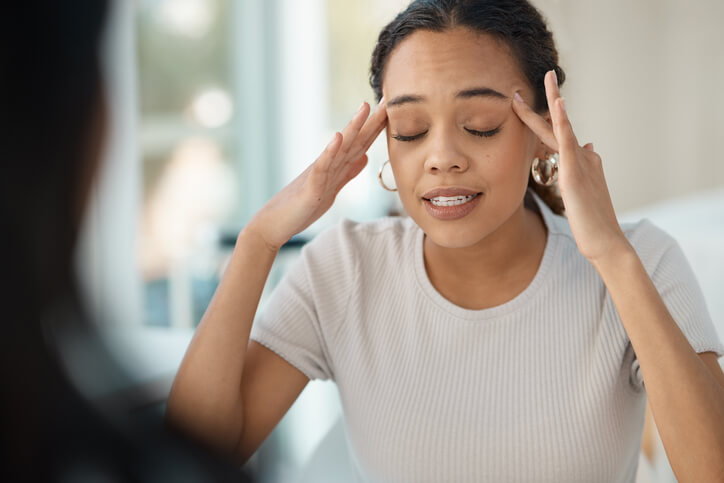 When my parents divorced, I was eight years old, which ultimately changed my way of thinking at the time. It felt like a shift in my brain, as soon after, I began performing these unknowingly repetitive tapping patterns on my arms. It wasn't until my ten-year-old sister saw me in the act and questioned what I was doing that I realized something wasn't right.
When my parents divorced, I was eight years old, which ultimately changed my way of thinking at the time. It felt like a shift in my brain, as soon after, I began performing these unknowingly repetitive tapping patterns on my arms. It wasn't until my ten-year-old sister saw me in the act and questioned what I was doing that I realized something wasn't right.
Twenty years later, I began attending counseling sessions with a therapist specializing in OCD, who helped me make sense of my childhood patterns that continued well into adulthood. These behaviors consisted of repeatedly checking my stove knobs, door locks, and alarm clock. I also avoided stepping on sidewalk cracks, ruminating on past and present conversations, and everything in my house had to be symmetrical. These rituals were incredibly debilitating and lasted for several hours each day. However, thankfully, they no longer exist.
Obsessive-Compulsive Disorder (OCD) is a common and chronic disorder where individuals struggle with intrusive and uncontrollable thoughts (obsessions) and, therefore, perform ritualistic behaviors (compulsions) to decrease unwanted thoughts. For example, individuals may line up everything by size in their refrigerator to avoid disturbing images.
Individuals with OCD tend to be perfectionists, pay strong attention to detail, and require extreme orderliness, interfering with daily activities at home, school, or work. They are often aware of their behaviors and feel shame and embarrassment.
Symptoms may include excessive hand washing, repetitive thought patterns, checking and unchecking, avoiding particular objects, and intrusive violent or sexual thoughts.
Although there is no proven cause of OCD, studies have correlated it to stressful life events, family history, other mental health disorders, and chemical changes affecting brain functioning.
OCD can be tricky but remedied, so here are some techniques to help decrease and eliminate its symptoms.
Journaling can be a great way to reduce intrusive thoughts, especially if you're experiencing them in the middle of the night. It doesn't have to be lengthy either, just enough to get it out of your head. For instance, jot it down if you can't stop replaying the seemingly embarrassing statement you made at work. Reading the thought rather than thinking can also help make light of the situation.
Do your thoughts cause constant worry or extreme anxiety? For example, you become afraid that something terrible will happen if you don't wash your hands repeatedly, such as a loved one involved in a car accident or colleagues laughing at you?
One technique used to challenge thoughts without judgment is called realistic thinking. So, if you decide to take a chance and wash your hands only five times instead of the usual six, ask yourself if anything terrible happened?
For example:
Several years ago, I experienced severe panic attacks around people in closed spaces and had horrific images of throwing chairs and screaming. My therapist taught me that my fears and compulsions only increased whenever I attempted to avoid intrusive thoughts. Therefore, the anxiety decreased when I allowed myself to make my rendition of the story, such as being taken away and hospitalized.
OCD tends to enjoy controlling your thoughts, and the more you avoid it, the more intrusive they become, thus increasing your anxiety and compulsions. Therefore, if you start to notice your OCD beginning to take control, follow through with a storyline, and create your ending.
When anxious, do you experience physical symptoms, such as stomachaches or headaches? The mind-body connection is a valid concept, so using some relaxation techniques can reduce the unwelcomed symptoms of anxiety.
OCD often causes us to isolate ourselves due to feelings of shame, embarrassment, and how debilitating it can be, thus preventing us from going anywhere. However, that will only increase one's anxiety. So, try to find a support group of peers that suits your needs.
Nowadays, support groups are more versatile than ever before. You can attend online or in-person peer-led groups, therapist-run groups, or online forums.
Living with OCD can be extremely challenging. Therefore, there is nothing wrong with seeking help from a therapist, as it can provide you with the necessary tools to work on unwanted thoughts and behaviors. Essentially, you will work on methods together and practice individually outside of therapy. Finding a therapist who specializes in OCD would be ideal. However, if not, make sure they have experience working with this particular diagnosis.
Here are some methods that your therapist may use specifically for OCD:
OCD can be frightening, and you may feel like you're losing control, but it is very treatable through practice, exposure, and support. You can take that power back when you begin to learn that a thought is only a thought and nothing else.